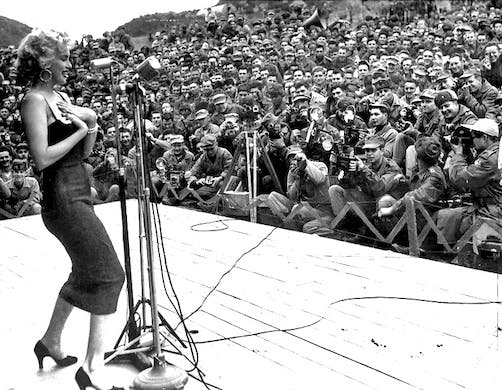Biographies: How America’s Princess Held Her Own Across the Pond
What happened when Marilyn Monroe came calling on a queen and her people.

‘When Marilyn Met the Queen: Marilyn Monroe’s Life in England’
By Michelle Morgan
Pegasus Books, 320 pages
Marilyn Monroe was American royalty. When she appeared at Pinewood Studios for the filming of “The Prince and the Showgirl” with Laurence Olivier, the English abandoned their vaunted reserve and treated her as a princess.
Marilyn Monroe behaved as the world’s gift, accessible to everyone, with a wave, always, to anyone who waved at her. She could seem accessible and yet out of reach, as frustrated reporters begged for yet more interviews and press conferences.
Monroe’s spontaneous wit came out in one-liners — all the more striking because, usually, she did not have much to say, tugging at her husband, Arthur Miller, who stood tall like a tribal elder protecting Pocahontas on her mission to the royals and their people.
How to build a book around a meeting between a queen and a movie star that lasted a few minutes? Dig deeply into records that correct errors in a seemingly familiar story and interview those still alive who witnessed Monroe’s entrance into a world alien to her, presided over by the world’s greatest actor who condescended to be her co-star. Or so it seemed to MM.
What distinguishes this biographer’s method is a shrewd tact that diffuses the customary attacks on Olivier for his ignorance of how to handle a method actress. You get the sense of an actor doing his best, and of Monroe — so wary of directors who had abused her — suspicious of commands like “be sexy” that Olivier may have meant in jest.
Acting was no joking matter to Monroe, who took her profession as seriously as Olivier. After all, the film could not have been made without her newly formed production company. Yet the tardy actress did not act as a producer, and resolute Olivier did — and that resulted in a fraught mismatch.
The prince in “The Prince and the Showgirl” is a stiff, arrogant royal who succumbs to the charm of Elsie Marina. She is best exemplified by an unscripted line that Monroe added. As she is backing out of the royal’s presence with a grace the clumsy royal himself has not been able to muster, she comments on her own performance, “Pretty good, huh?”
Ms. Morgan reports: “The improvised line fitted into the film so nicely that it was kept in.” Was Monroe speaking directly to Olivier, showing him just what she could do without his direction?
Arthur Miller tried to remedy the miscommunication between Olivier and Monroe and failed, writing about his disappointment in a journal that she discovered when looking for her script. This is a powerful moment in the marriage, which most biographers dwell on. So does Ms. Morgan, but with a difference. She points out that, after all, Miller was a writer and wrote things down — things he might have meant just for that moment.
Monroe, quick to detect a betrayal, believed her husband had gone to the dark side — that is to Olivier’s. Okay, but as Ms. Morgan carefully explains, too much can be made of a moment, and the marriage would renew itself for some time as Monroe found some genuine relief off the screen in a home life that Miller was quite adept at providing for her.
What of the queen? Turns out, on evidence Ms. Morgan reveals for the first time, the monarch was as pleased to meet MM as her subjects were. The actress performed a perfect curtsy, spending, it seems, as much time on her wardrobe and her gestures as she did at another noted command performance, for President Kennedy.
When a biographer decides to delve into an oft-told tale, she had better have something new to say. What is new here is not only the subtlety of this account, exploring the nuances of American and English culture, but also the comprehensive readings of how people — on set, in the streets, in chance encounters — responded to Monroe, including those who thought she was no big deal.
This biography has a coda, a moving portrayal about how those who met and worked with Monroe on and off the set of “The Prince and the Showgirl” reacted to her death. This deft addition to the story of events that occurred over only four months elevates “When Marilyn Met the Queen” into a narrative of much greater significance than many biographies that deal with a whole life.
Mr. Rollyson is the author of “Marilyn Monroe: A Life of the Actress,” “Marilyn Monroe Day by Day,” and “Female Icons: Marilyn Monroe to Susan Sontag.”

